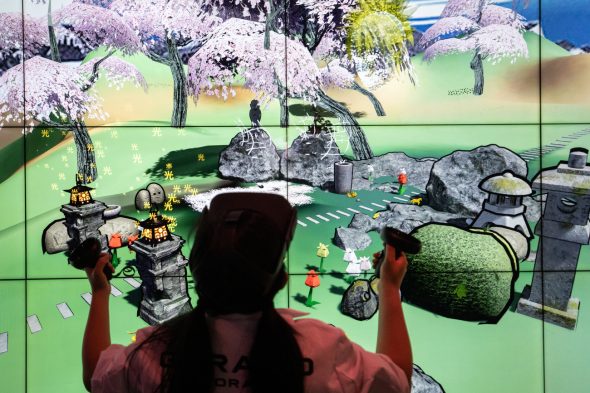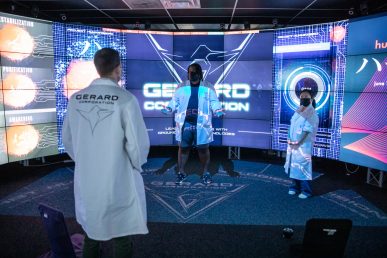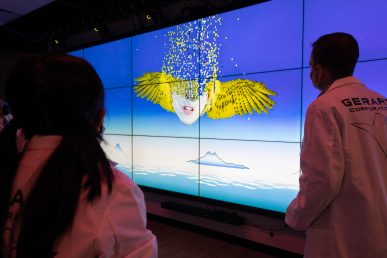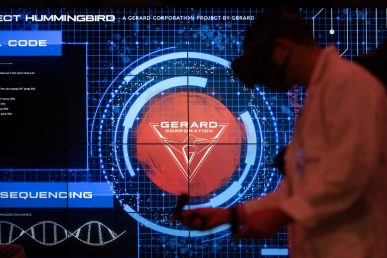UIC’s ‘Hummingbird’ play a union between design, engineering and theater in virtual reality

When the few selected audience members walked into the University of Illinois Chicago’s Electronic Visualization Laboratory recently, they were quickly given lab coats and virtual-reality headsets to put on.
Thanks to those headsets, they were instantly transported to a world deep underwater, in a dark cave and flying high above the sky with hummingbirds.
What was taking place was a live theater workshop for “Hummingbird,” an immersive play that was the brainchild of Daria Tsoupikova, professor in the school of design, Jo Cattell, an award-winning theater director, and members of the visualization laboratory, including Andrew Johnson, director of research at the Electronic Visualization Laboratory or EVL.
The idea began in 2018 when Cattell, who ended up writing and directing “Hummingbird,” and Tsoupikova began thinking of a way to collaborate.
“Because Jo’s interest is in immersive theater and my interest is in virtual reality and the expertise of the Electronic Visualization Lab for 48 years, we decided to do this amazing novel project together,” Tsoupikova said.
The project was awarded a grant in 2019 from the University of Illinois System’s UI Presidential Initiative: Expanding the Impact of the Arts and the Humanities, Office of the Vice Chancellor for Research Creative Activity award in 2020 and a 2021 grant from the National Endowment for the Arts.
“Transforming Storytelling: Multi-User Virtual-Reality Theater for Collaborative Tele-Immersive Exploration” is a collaboration involving 12 people including Johnson, who is also a computer science professor in the College of Engineering; Lance Long, computer science and EVL senior research programmer; CS/EVL Ph.D. student Arthur Nishimoto; CS/EVL Ph.D. student Sai Priya Jyothula; actors Stephanie Shum, Dwight Sora and Devonte Washington; stage producer Denise Savas; music composer Megumi Katayama; videographer Liviu Pasare; and Jo Cattell, who received the Goodman Theatre’s 2018 Michael Maggio Directing Fellowship. In addition, 15 design students from the School of Design’s Creative Coding course designed the graphic design identity and branding used in the performance and the theater exhibition to transform EVL into theater. The team partnered with the Goodman Theatre’s Alice Rapoport Center for Education and Engagement, whose youth program works with Chicago’s diverse demographics of middle-grade and teenage kids (ages 11–18).
“From my perspective, it’s a very different kind of way of working than it is in normal theater production, so it’s been really exciting for me,” said Cattell, who had to write the script keeping in mind what was possible in virtual reality. “Something we really wanted to do was to show how this technology can really tell a story that is completely different than any other theatrical show, something we can’t do on a live stage.”
The aim had been for the play to be in the Goodman Theater New Stages in 2020, which showcases new and experimental shows, but because of the pandemic, theaters across the country were shuttered, including the Goodman.

The play itself draws on its integration of science, theater and design. The story begins as Dr. Deni Higashi, lead programmer at fictional Gerard Corp, has developed a new technology that can transfer a person’s contained living energy, or soul, into a new body. There’s just one problem — a glitch in the program, resulting in a zero success rate in clinical trials. Gerard, CEO of Gerard Corps, is desperate for his soul to be transferred as soon as possible. In order to pressure Dr. Higashi into fixing the glitch, Gerard has kidnapped her daughter, Aya, whom he forces along with other test subjects through HBT, or Hummingbird Technology. Once inside the program, they have to complete three stages, Destabilization, Purification and Awakening, so that their souls can be transferred successfully. Stubborn and selfish, Gerard refuses to work with the rest of the team to complete the stages, assuming that their success is his success. However, as Aya flies her way to freedom, Gerard finds himself trapped in the program, his unstable soul disintegrating and disappearing into digital space.
Tsoupikova said the aim was to have the “Hummingbird” play be presented in several theaters at the same time. She hopes that the play, which is currently in workshops, will debut on the Goodman stage this season.
EVL was established in 1973 and pioneered real-time interactive graphics and video game technology. In the 1980s, it began focusing on scientific visualization; in the 1990s, it focused on advanced virtual reality and on high-speed networking infrastructure; and in the 2000s, on accessing, sharing and displaying ultra-high-resolution images on tiled display walls, including its CAVE2VR theater.
“It’s what EVL was created to do nearly 50 years ago — it’s the kind of thing we do,” Johnson said. “Everything we do here is about collaboration, it’s about interaction, it’s about different groups working together on things. It’s always about finding new ways to apply technology and new ways to help people tell stories.”


